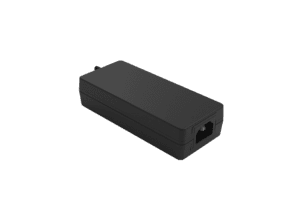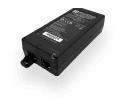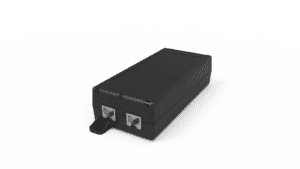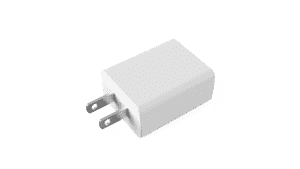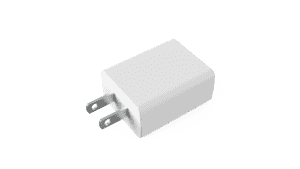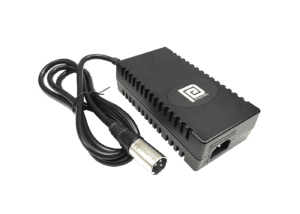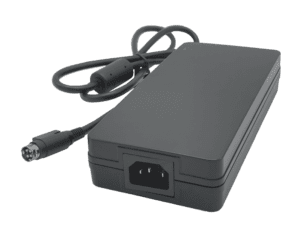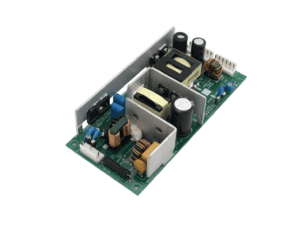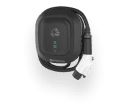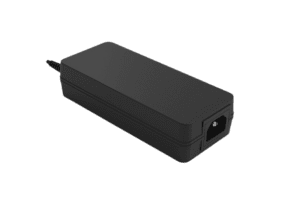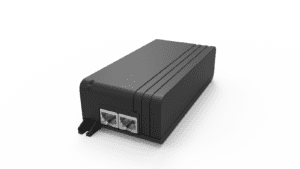BLOG
Active vs Passive PoE Injectors: Understanding the Key Differences
Table of contents

Power over Ethernet (PoE) technology has transformed the way we power and connect devices in office and business environments. By delivering electrical power alongside data over standard Ethernet cables, PoE simplifies installations, reduces costs, and enhances flexibility. Within PoE technology, there are two choices; active or passive. Understanding the differences between these types is important for ensuring safe and efficient power delivery. In this article, we’ll explore the distinctions between active vs passive PoE injectors, their operational principles, and how to select the ideal type for your needs.
What is Power over Ethernet?
Before diving into the specifics of active vs passive PoE injectors, it’s important to understand the basic concept of PoE. Power over Ethernet (PoE) allows a single Ethernet cable to provide both data connectivity and electrical power to devices such as IP cameras, wireless access points (WAPs), and VoIP phones. This eliminates the need for separate power supplies and outlets, simplifying network installations and reducing wiring costs.
What are PoE Injectors?
PoE injectors are essential devices that introduce PoE functionality into non-PoE network setups. These compact units inject DC power into Ethernet cables, transforming them into dual-purpose conduits capable of transmitting both data and electrical power to PoE-enabled devices. Moreover, PoE injectors are invaluable in scenarios where dedicated PoE switches are unavailable or not feasible.
PoE injectors adhere to standards such as IEEE 802.3af/at/bt, ensuring compatibility with a wide range of PoE-compliant devices. They come in various configurations, including single-port and multi-port models, catering to diverse deployment needs from small-scale installations to large-scale network expansions.
What are PoE Standards?
PoE standards are the guidelines that define how network cables can carry electrical power along with data. The Institute of Electrical and Electronics Engineers (IEEE) defines these PoE standards and promotes the development and application of electrotechnology. As far as PoE, there are three industry standards; IEEE802.3af (PoE), IEEE802.3at (PoE+), and IEEE802.3bt (PoE++). These standards specify power levels, wiring configurations, and other technical parameters to ensure safe and efficiency delivery of power over ethernet cables.
IEEE 802.3af (PoE)
The journey of Power over Ethernet (PoE) standards started in 2003 with the IEEE 802.3af standard. This milestone, often referred to simply as PoE, laid down the rules for delivering 15.4 watts of power from Power Sourcing Equipment (PSE) and 12.95 watts at the Powered Device (PD) using 44-57 volts of DC power over Cat5 Ethernet cables. Initially utilized for VoIP (Voice Over IP), it quickly found applications in wireless access points (WAPs) and low-power surveillance cameras. The IEEE 802.3af standard ensures devices from various manufacturers work together seamlessly, offering a dependable and widely accepted solution for powering network devices.
IEEE 802.3at (PoE+)
In 2009, the IEEE introduced the 802.3at standard, also known as PoE+, as an enhancement to the original PoE standard. It increased the power delivery capacity to 30 watts from the PSE and 25.5 watts at the PD over Cat5 cables. This upgrade supports more power-hungry devices such as PTZ cameras, high-speed wireless access points, and video IP phones. PoE+ ensures backward compatibility with IEEE 802.3af, allowing you to power older devices while providing additional power for newer, more demanding equipment.
IEEE 802.3bt (PoE++)
The IEEE launched the 802.3bt standard in 2018 to address the need for even more power. Known as Hi Power PoE (Hi-PoE) or PoE++, this latest standard offers between 60 to 90 watts of power from a PSE. It is backward compatible with both IEEE 802.3af and IEEE 802.3at standards, supporting devices that require anywhere from 51 to 71.3 watts. This significant power boost makes it ideal for high-power devices such as digital signage, LED lighting, and advanced wireless access points. Moreover, IEEE 802.3bt provides enhanced flexibility and scalability, meeting the demands of modern networks with power-intensive applications.
Active PoE Injectors
Active PoE injectors are smart devices that negotiate power levels with PoE-enabled devices to deliver the precise amount of power needed. Unlike passive injectors, which deliver power indiscriminately, active injectors communicate with the powered device (PD) using a handshake protocol defined by IEEE standards 802.3af/at/bt. This negotiation ensures that the PD receives optimal power levels, reducing the risk of potential damaged caused by overloading voltage or underpowering.
Applications
Active PoE injectors excel in environments requiring precise power management and strict adherence to industry standards. Here are some key industries where Active PoE is essential:
Wireless Networking: Vital for powering wireless access points (WAPs) indoors and outdoors, ensuring robust Wi-Fi coverage without additional power outlets.
Telecommunications: VoIP phones rely on active PoE injectors for streamlined installation and clutter-free operation in office environments.
Retail: Point of Sale (PoS) systems, including terminals and digital signage, benefit from active PoE for simplified installation and continuous operation.
Industrial Automation: Used in rugged industrial settings to power IP cameras, sensors, and controllers, ensuring reliable performance in harsh conditions.
Transport and Logistics: Powering IP cameras, access control, and WAPs in hubs enhances security and operational efficiency.
Advantages and Benefits:
Active Management: Efficiently allocates power based on device needs, optimizing power usage.
Standards Compliance: Meets IEEE 802.3af/at/bt standards for enhanced safety and interoperability.
Reliability & Safety: Prevents underpowering or overloading, extending device lifespan and reliability.
Considerations:
Cost: Higher initial investment due to advanced features like power negotiation and overload protection.
Power Budgeting: Calculate total power requirements to avoid exceeding injector limits.
Network Design: Optimize network layout for efficient power delivery and performance.
This concise overview captures the versatility and benefits of Active PoE injectors across diverse industries while highlighting essential considerations for deployment and management.
Passive PoE Injectors
Passive PoE Injectors deliver power over ethernet without adhering to any IEEE 802.3 standard or negotiating with the powered device. They provide continuous power, making them suitable for devices with fixed power requirements and those that don’t require power negotiation. Moreover, their simplicity makes them more cost-effective and easier to implement. They’re commonly used in simple network installations, outdoor setups, and legacy devices. They’re suitable for basic, low-power applications where cost is a primary concern and device compatibility is well understood.
Applications
Passive PoE injectors are perfect for straightforward setups where advanced power management isn’t required. They are often used in simpler environments where basic power delivery is sufficient. Key industries include:
Small Office/Home Office: Passive PoE injectors are prevalent in these setups, powering devices like IP cameras and wireless access points, offering a cost-effective networking solution.
Simple Surveillance Systems: In small-scale surveillance, passive PoE injectors simplify IP camera installation and management without extra power outlets.
Wireless Bridges: These injectors supply power to outdoor wireless bridge devices, connecting network segments with low, fixed power requirements.
Small Retail Installations: Passive PoE supports point-of-sale terminals and digital signage, streamlining installations with fewer power outlets needed.
Low-Power LED Lighting: Passive PoE injectors also power low-power LED lighting systems, providing an affordable lighting solution.
Advantages and Benefits:
Cost-Effective: Simplified design and lack of negotiation circuitry contribute to lower costs.
Ease of Installation: Plug-and-play setup without configuration simplifies deployment.
Considerations:
Fixed Power Output: Delivering constant voltage and power levels may not suit devices with varying power needs, potentially damaging them.
Compatibility Issues: Users must match voltage and power outputs to device requirements to prevent compatibility issues.
Safety Concerns: Passive PoE lacks IEEE 802.3 compliance, risking devices and networks without standardized power negotiation and safety features.
No Power Monitoring: Absence of power monitoring can lead to inefficiencies and operational issues over time.
How Do You Choose Between Active vs Passive PoE Injectors?
Active and passive PoE injectors offer distinct advantages depending on your specific deployment requirements. Active injectors provide intelligent power management, compliance with IEEE standards, and enhanced reliability for devices requiring precise power delivery. However, passive injectors offer simplicity, cost-effectiveness, and compatibility with a wide range of devices, making them ideal for straightforward installations or legacy equipment.
By understanding the differences between active vs passive PoE injectors and considering your network’s specific needs, you can confidently choose the right type of injector to optimize power delivery and performance across your network infrastructure. Whether prioritizing advanced management or cost-effective deployment, PoE injectors modernize connectivity and enhance device functionality.
See All of Phihong’s Passive and Active PoE Injector Products
What Makes Phihong the Top Choice for PoE Solutions?
When it comes to active vs passive PoE injectors and customized solutions, Phihong emerges as a standout choice for several compelling reasons. Moreover, let’s delve into what sets Phihong apart as a leader in the PoE industry.
Driving Innovation and Setting Standards
Phihong has been a trailblazer in PoE innovation, consistently pushing the boundaries of technology and actively shaping industry standards. Moreover, as the sole power supply manufacturer on the IEEE PoE committees, Phihong plays a crucial role in advancing PoE standards, from contributing to AT/BT standards to influencing IEEE PoE discussions. This involvement positions Phihong as the preferred supplier and manufacturer for OEMs seeking cutting-edge PoE solutions.
Unrivaled Dependability
At Phihong, reliability is paramount. Therefore, every product undergoes rigorous testing and quality control measures to ensure flawless performance, even in the most demanding environments. By choosing Phihong, you are trusting in stable and efficient network infrastructure, thus minimizing downtime and maintenance costs.
Local Expertise for U.S. Businesses
For U.S.-based OEMs seeking tailored PoE solutions, Phihong offers distinct advantages:
Firstly, Strategic Location: Based in the heart of Silicon Valley, our proximity to tech giants ensures swift logistics and timely delivery of products.
Secondly, Local R&D Facilities: Our on-site research and development capabilities enable rapid innovation and customization to meet the specific needs of American OEMs, fostering close collaboration and efficient product development.
Lastly, Dedicated U.S. Support: With a focus on customer satisfaction, Phihong provides responsive U.S.-based customer support. Our engineers offer timely assistance, technical expertise, and troubleshooting, ensuring a seamless experience for our clients.
CLIENT'S QUOTE
Phihong's Power-Over-Ethernet solutions have transformed our network, boosting efficiency and reducing costs. Their seamless integration has simplified both installation and maintenance.
Explore More with Phihong USA
As we conclude our exploration of PoE technology, it’s clear that this field is experiencing unprecedented growth. For over 50 years, Phihong has been at the forefront of innovation, serving Fortune 500 companies across various industries as a leading power supply manufacturer for OEMs.
Phihong’s leadership, particularly in advanced technologies like Power over Ethernet, extends to active contributions in the development of IEEE PoE standards. This involvement underscores our commitment to innovation and dedication to providing cutting-edge power solutions that will shape the future of technology.
In addition to custom power supply solutions, Phihong offers a diverse range of products, including:
- Power over Ethernet (PoE) Solutions: PoE injectors, splitters, media converters, and more
- AC/DC Adapters and Power Supplies: USB adapters, desktop adapters, industrial-grade power supplies, and more
- Battery Chargers: Chargers for lithium-ion and lead-acid batteries
- Medical Power Supplies: Specialized power supplies that meet stringent healthcare requirements
By partnering with Phihong USA, you are choosing a trailblazer in power technology. If you’re an OEM looking for a custom PoE solution or just looking for a quality product, call us today: 510-445-0100 or email us at usasales@phihongusa.com. We look forward to collaborating with you.

Contact Our Team Today!
Our dedicated sales team and international partners are prepared to support you with your latest projects and initiatives globally.
FAQ
What is the difference between active and passive PoE injectors?
Active PoE injectors use a negotiation protocol to communicate with powered devices, delivering the precise amount of power needed and ensuring safety and efficiency. In contrast, passive PoE injectors provide a fixed amount of power without negotiation, making them simpler and more cost-effective but potentially less safe for devices with varying power needs.
What are the main applications for PoE injectors?
PoE injectors are widely used in various applications, including powering wireless access points, IP cameras, VoIP phones, point-of-sale systems, and low-power LED lighting. Active PoE injectors are ideal for environments requiring precise power management, while passive PoE injectors suit simpler setups with fixed power requirements.
Why choose Phihong for PoE solutions?
Phihong is a leader in PoE technology, known for its innovation, reliability, and local expertise. As the only power supply manufacturer on the IEEE PoE committees, Phihong actively shapes industry standards. The company also offers rigorous testing and quality control, along with dedicated U.S. support to meet the specific needs of American OEMs.

